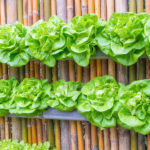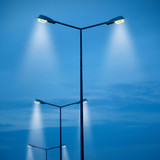Agriculture Experiments With 'Vertical Farming'
Anyone paying attention to the world-wide agricultural community right now can tell you that things are... getting weird. Frustrated farmers, high costs, record food demand, environmental factors and government regulations are all clashing to create a very uncertain time for farmers and food producers. Fortunately, we have the technology to attempt to make food production easier. One fascinating example of this is what's called 'vertical farming'.
Across the world, college students and massive corporations alike have experimented with a type of alternative farming that grows crops sustainably in an indoor space with high powered LED lighting. It uses no synthetic fertilizers, herbicides, or pesticides. Often, crops can hang in vertical troughs as they grow -- especially short, leafy crops like lettuce and spinach -- hence the name 'vertical farming'.
Smaller vertical farming projects have taken place in converted areas like trailers and shipping containers. Large-scale alternative agricultural projects can even take over whole warehouses. The warehouse lighting fixtures are replaced with special LEDs. These aren't your typical white solar parking lot lights or yard-illuminating LEDs. They're specially designed LEDs in the red and blue color spectrums, optimized for growing nutritionally complete plants even without proper sunshine.
One of the main issues with vertical farming? The energy use. LED lights do consume far less energy than traditional lighting. In fact, an LED bulb uses only about 15% of the energy a comparable halogen bulb would, and with 85% more light output to boot. That's why solar parking lot lighting, replacing neon signs with LED signs, and LED screens are all booming in popularity. But the large strings of LEDs used in vertical farming still need to be on up to 16 hours a day to make up for the plants' lack of sunlight, which consumes a lot of energy.
Vertical and small-space farming is so promising for small communities and rough climates to produce fresh, healthy produce, so it's disappointing that they aren't more widespread due to the potential costs. The good news? New advancements in LED technology are being tested and discovered all the time. Hopefully soon enough we'll be able to reduce the cost of running LEDs even further to facilitate big, world-altering projects like vertical farming.
Recent Posts
-
Can LED Lighting Reduce Crime or Is It a Placebo Effect?
When it comes to enhancing security, a common question is whether LED lighting can reduce crime or i …Feb 16th 2024 -
Street Lighting and the Impact on Business Districts
Business districts are important places for people to shop, eat, conduct business, and explore the c …Jan 26th 2024 -
Are Solar Street Lights Reliable? Debunking the Common Myth
As the world continues to search for more sustainable and environmentally friendly sources of energy …Jan 22nd 2024






